Carrot Lentil Purée
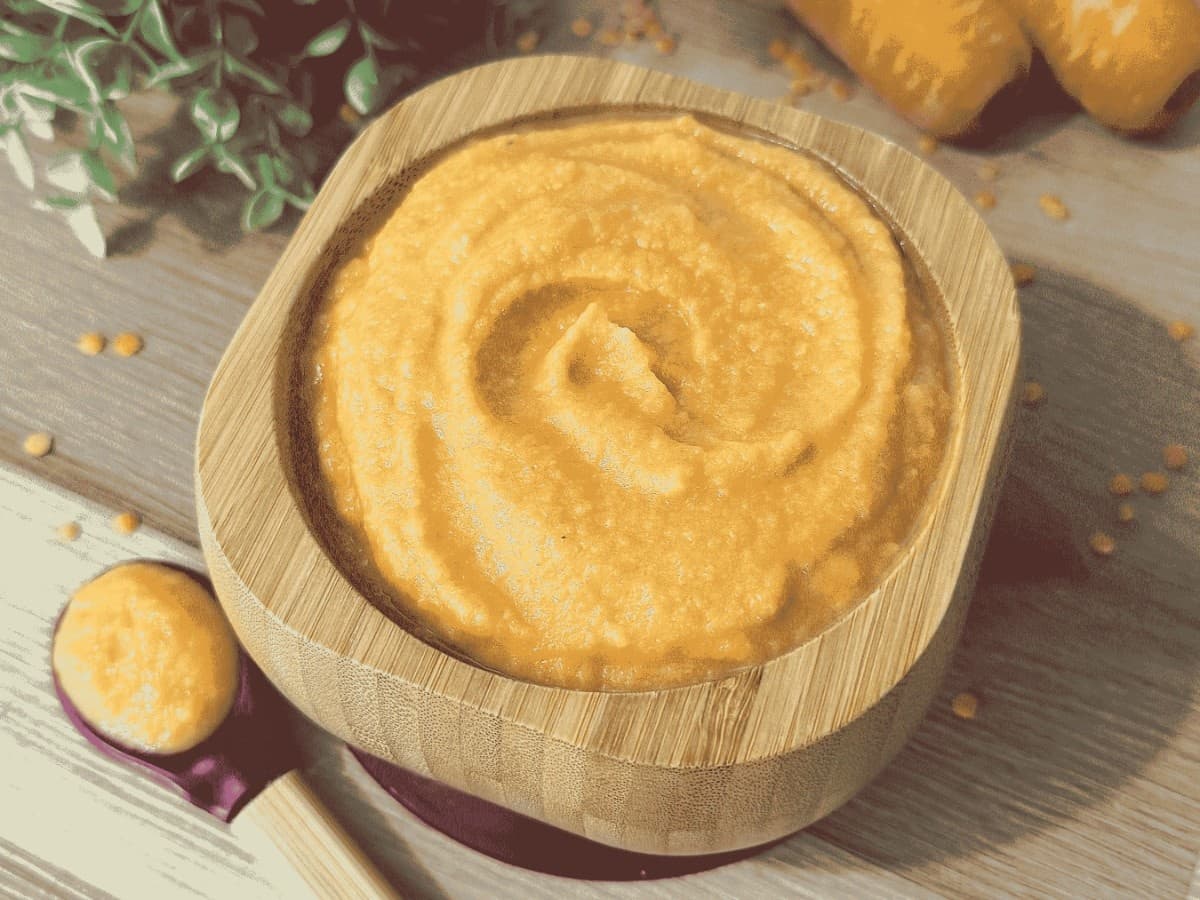
Written by Kenny Ekerin
Fact Checked by Mindsmaking Professionals
24th, November, 2025
This post may contain affiliate links. Please read our disclosure policy.
Looking for a healthy homemade baby food recipe? Try this Carrot and Lentil Puree! Full of vitamins, fiber, and iron, it’s a nutritious and easy-to-digest meal to support your baby’s growth and development. Perfect for babies starting solids!
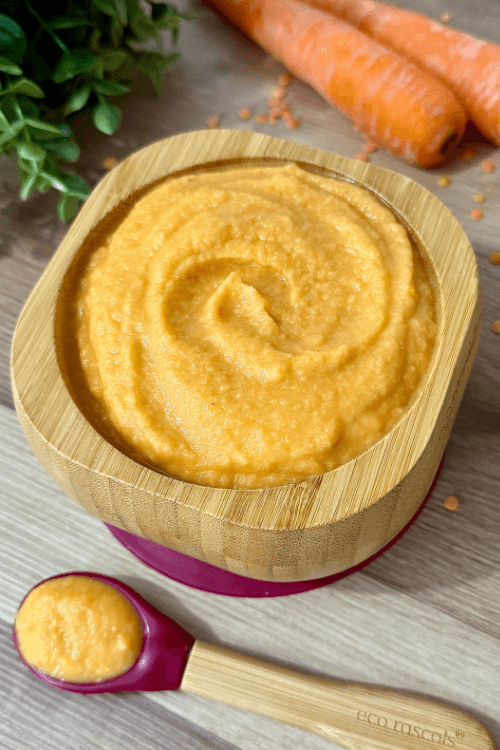
Why this Purée is Great for Babies
First, both carrots and lentils are highly nutritious. Carrots are rich in beta-carotene, a precursor to vitamin A, which is essential for healthy vision, immune function, and skin health. They also provide a good source of fiber, which supports digestive health
Lentils, on the other hand, are an excellent source of plant-based protein, iron, and fiber, which are important for your baby’s growth, muscle development, and overall health.
This puree is easy to digest, which makes it ideal for babies who are just starting solids. The soft texture from blending the carrots and lentils helps ensure that the food is gentle on a baby’s developing digestive system.
Additionally, the combination of carrots and lentils provides a balanced mix of carbohydrates, proteins, and healthy fats (from the butter and milk), which are all essential for your baby’s development.
The addition of unsalted butter provides healthy fats, which are crucial for brain development, while milk adds extra calcium and supports bone growth. The butter also enhances the flavor and smoothness of the puree, making it more appealing to babies.
Overall, this Carrot and Lentil Puree is a wholesome, easy-to-digest, and nutrient-dense food that supports your baby’s growth and development during their early stages of eating solids. It’s also a great way to introduce your little one to a variety of textures and flavors.
Carrot Lentil purée Recipe
Ingredients:
- 1/2 cup lentils (red or yellow lentils are ideal for babies as they cook quickly)
- 2 medium carrots, peeled and chopped
- 1/2 tablespoon unsalted butter
- 1 1/2 cups water
- 1/2 cup milk (breast milk, formula, or regular milk, depending on your baby's age and preference)
Mindsmaking
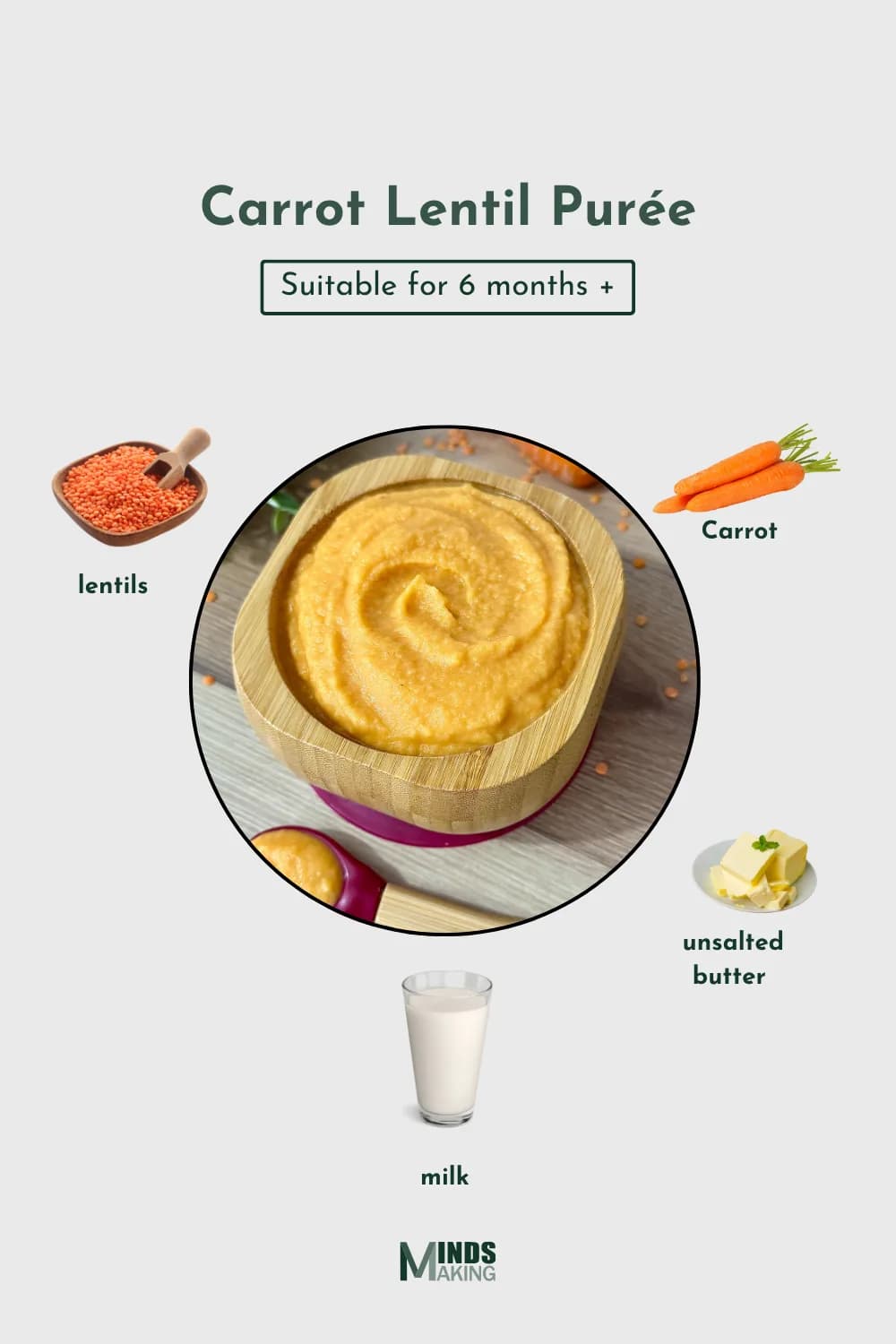
Instructions
1. Prepare the Ingredients: Peel and chop the carrots into chunks. Rinse the lentils thoroughly under cold running water to remove any dirt or impurities.
2. Cook the Carrots and Lentils: In a saucepan, combine the 1/2 cup lentils, chopped carrots, and 1/2 tablespoon of unsalted butter. Add 1 1/2 cups of water to the saucepan. The water will help cook the lentils and carrots, softening them for blending. Bring the mixture to a boil over medium-high heat. Once it reaches a boil, reduce the heat to a simmer.
Cover the saucepan and let everything simmer for about 8-10 minutes, or until the lentils and carrots are soft and tender. The water will almost evaporate during this time, leaving a thick, cooked mixture.
Mindsmaking
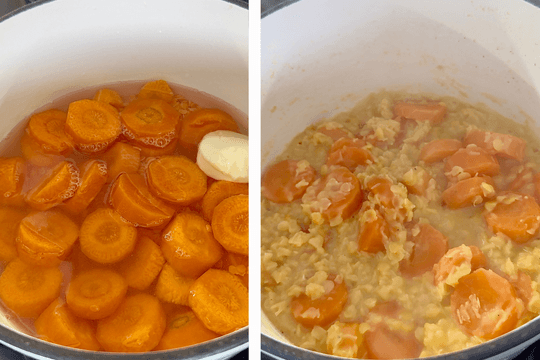
3. Cool the Mixture: Once the lentils and carrots are cooked through, remove the saucepan from the heat and allow the mixture to cool to room temperature. This will make it safer for your baby and easier to blend.
4. Blend the Puree: Transfer the cooled lentil and carrot mixture to a baby food blender. Add 1/2 cup of milk (breast milk, formula, or regular milk, based on your preference). Blend everything together until smooth or textured. You can add more milk gradually if the puree is too thick, to reach the desired consistency for your baby.
Mindsmaking
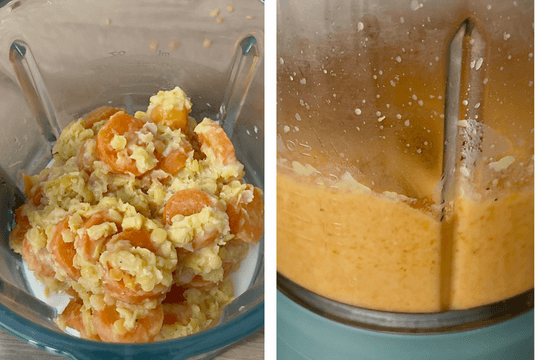
5. Serve: Once the puree is blended to your liking, pour it into a baby bowl. Let it cool down to a safe temperature before feeding it to your baby
Read This Next

Recipe Ebook
Essential Guide to Starting Solids for Babies 6 Months+ - LBH Top 70 Baby Puree & Porridge Recipes eBook.
Start your baby’s solids journey with confidence using this "70 Baby Purees & Porridges" eBook! Created with care, this digital guide is packed with nutrient-rich recipes for babies 6 months and older, including purees and porridges tailored to each stage of your baby’s development.
Mindsmaking
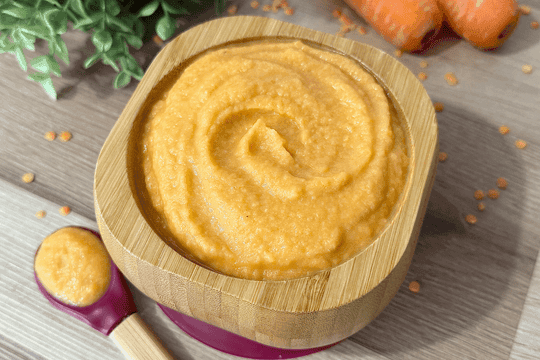
Tips for success
First, make sure to choose the right lentils. Red or yellow lentils are ideal because they cook faster and become very soft, making them perfect for purees. If you decide to use other types of lentils, like green or brown, keep in mind that they take longer to cook and may result in a thicker texture that can be harder for babies to digest.
It’s important to cook the lentils thoroughly. They should be soft and tender before blending. If needed, add extra water and cook them for a little longer. Undercooked lentils may be hard to digest for your baby, so ensure they are fully softened before moving to the next step.
When chopping the carrots, make sure to cut them into small, uniform pieces. This ensures they cook evenly and soften more quickly. The smaller the carrot pieces, the faster they will cook,
Be sure to simmer the mixture gently rather than boiling it rapidly. Bringing the mixture to a gentle boil and then reducing it to a simmer will help cook everything evenly. Boiling too quickly could lead to uneven cooking and may cause the water to evaporate too fast, leaving you with a dry mixture.
Before serving, always allow the puree to cool to room temperature. Babies are sensitive to hot food, so make sure to check the temperature to avoid burning your baby’s mouth.
When introducing new foods, it’s a good idea to do so gradually. If this is one of your baby’s first meals, offer the puree in small amounts to see how they respond. You can also experiment with adding mild herbs like parsley or cumin once your baby is familiar with the basic flavor.
Always monitor your baby after introducing a new food to check for any allergic reactions. While lentils are generally safe, it’s important to stay cautious when offering legumes to babies.
Serving suggestions
Pair the carrot and lentil puree with a simple fruit puree like apple puree, pear puree, or banana puree. This not only adds variety but also introduces your baby to new flavors, making mealtime more interesting.
Once your baby is familiar with the carrot and lentil flavor, you can lightly sprinkle some ground cinnamon over the puree. This adds a warm, subtle flavor that many babies enjoy. Make sure to use cinnamon sparingly, as it’s a strong flavor.
For babies who are ready for a bit more complexity in taste, you can add mild herbs like parsley or basil. These herbs can help introduce your baby to more diverse flavors, all while being gentle on their sensitive taste buds.
To expand the variety of nutrients, you can blend in other soft, cooked vegetables like peas, sweet potatoes, or butternut squash. These vegetables pair well with carrots and lentils, offering a broader spectrum of vitamins and minerals.
For older babies who are practicing self-feeding, you can spread the carrot and lentil puree onto soft toast or crackers. This will allow them to explore new textures and develop their fine motor skills.
If your baby is older and used to drinking thicker liquids, you can use the carrot and lentil puree as a base for a healthy baby smoothie. Add a little milk or water, blend it with some soft fruit, and you have a nutritious drink they’ll enjoy.
Once your baby is used to purees, you can mix the carrot and lentil puree with mashed rice or quinoa to introduce some grains into their diet. This will add texture and extra energy in the form of complex carbohydrates.
For a fun twist, you can freeze the puree into baby-friendly popsicle molds. It’s a great way to serve the puree in a new way, especially for teething babies who may enjoy the cold relief.
How to Store
First, allow the puree to cool down to room temperature before placing it in the refrigerator. This helps to avoid raising the temperature inside the fridge, which could promote bacterial growth. Once the puree has cooled, transfer it into an airtight container or a baby food jar to keep it fresh and free from contamination.
You can store the puree in the refrigerator for up to 1-2 days. It’s important to remember that once the puree is stored in the fridge, it should be used within this time frame for safety and quality. After 2 days, the puree may begin to lose its freshness and nutritional value, so it’s best to discard any leftovers that have been stored longer than that.
If you'd like to store the puree for a longer period, freezing it is a great option. You can pour the puree into ice cube trays or silicone baby food trays to create small, individual portions. This makes it easy to thaw only the amount you need for each meal, reducing waste. Once the puree is cool, transfer it to the ice cube tray or a freezer-safe airtight container. Be sure to seal the container properly to prevent freezer burn.
The puree can be stored in the freezer for up to 2 months, and it’s a good idea to label the container with the date it was made.
When it's time to thaw the puree, the best method is to place it in the refrigerator overnight. This ensures it stays at a safe temperature while thawing. If you need to thaw it more quickly, you can place the container or ice cubes in a bowl of warm water (make sure it’s not too hot) or use the defrost setting on your microwave.
After thawing, reheat the puree gently on the stove or in the microwave. Always stir it well and check the temperature before serving it to your baby to ensure it’s not too hot.
It’s important to avoid refreezing any puree that has been thawed. Repeated freezing and thawing can affect the texture, flavor, and nutritional value of the puree. Once thawed, try to use it within 24 hours for the best quality.
For long-term storage, it's better to avoid using glass jars with metal lids, as the metal can rust over time. Instead, use plastic or BPA-free containers, which are safer for long-term use. Also, freezing in small portions (about 1-3 tablespoons) makes it easier to thaw only the necessary amount and avoid reheating multiple times.
Frequently Asked Questions
At what age can I start offering this puree to my baby?
This puree is great for babies around 6 months old who are starting solids.
Which type of lentils should I use?
Red or yellow lentils are best because they cook quickly and become soft. They're easier for babies to digest compared to green or brown lentils.
Is this puree safe for babies with dairy allergies?
Yes, just skip the butter and use a dairy-free alternative like oat milk or stick with breast milk or formula.
Can I freeze this puree?
Definitely. Freeze in small portions using an ice cube tray or silicone molds. Once frozen, transfer to a freezer-safe container or bag. It will keep for up to 2 months.
How do I thaw and reheat the puree?
Thaw it overnight in the fridge or place frozen cubes in warm water. You can also use the defrost setting on your microwave. Always stir well and check the temperature before serving.
What if the puree is too thick?
Add a little more milk, formula, or water and blend again until it reaches the consistency your baby prefers.
Can I add spices or herbs?
Yes! Once your baby is comfortable with the basic flavor, you can add a tiny pinch of cinnamon, cumin, parsley, or basil to introduce new tastes.
Can I mix this with other foods?
Absolutely. It goes well with mashed rice, quinoa, peas, sweet potatoes, or mild fruit purees like apple or pear.
How long does this keep in the fridge?
Store it in an airtight container and use within 1 to 2 days. If it has been sitting at room temperature for more than 2 hours, it is best to discard it.
Is this good for baby-led weaning?
Yes, with a little adjustment. You can spread the puree on soft toast or use it as a dip for soft vegetables if your baby is doing baby-led weaning (BLW) and ready for finger foods.
What are the nutritional benefits?
This puree is packed with protein, iron, fiber, and vitamin A. It supports brain development, strong bones, digestion, and immune health.
Can I use canned lentils?
It’s better to use dried lentils so you can control sodium and texture. If using canned, make sure they’re unsalted, rinse them well, and cook with carrots to soften.
What texture should I aim for?
For younger babies, keep it smooth and thin. As your baby gets older, you can blend it less or mash it to add a bit of texture for chewing practice.
Was this article helpful?
How many stars are you giving this article?
Leave a comment
Your email address will not be published.
Comments
More From Recipe
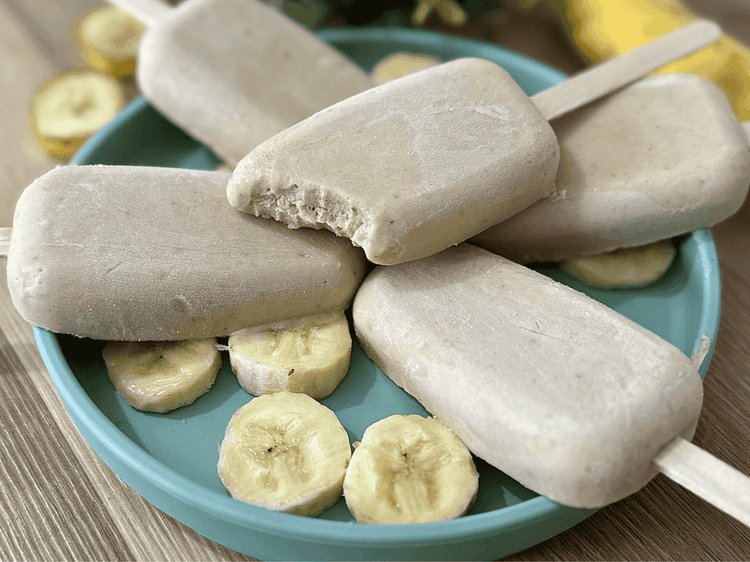
Homemade Banana Popsicles

Easy Blueberry Avocado Pancakes
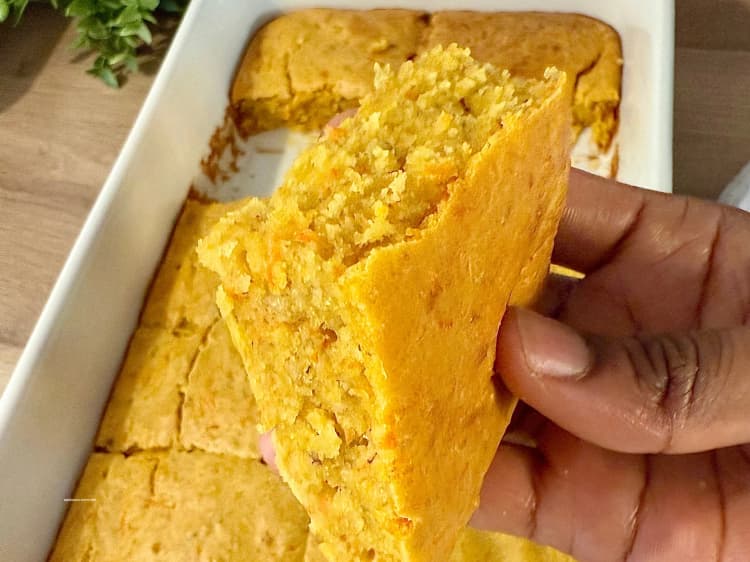
Applesauce Carrot Breakfast Cake

Carrot Potato Tots
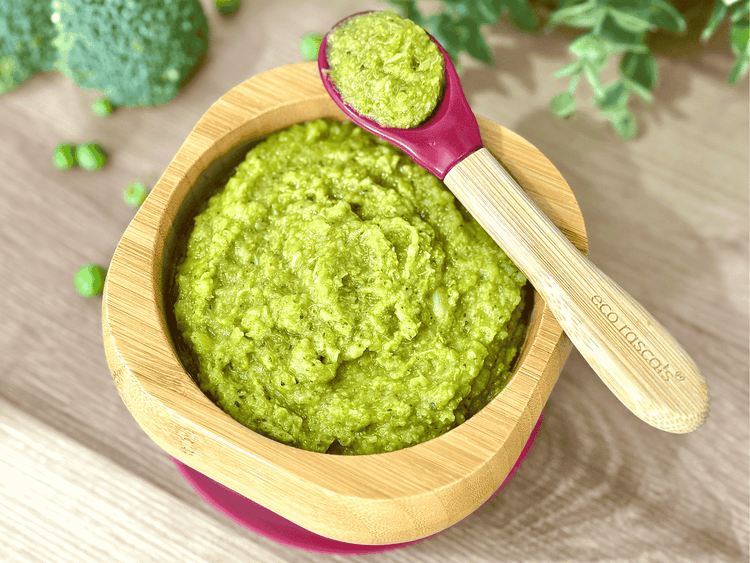
Broccoli & Pea Curry Purée

Berry, Banana & Pear Purée
Get new recipes to your inbox
Subscribe to our weekly newsletter and get new recipes sent to your inbox!